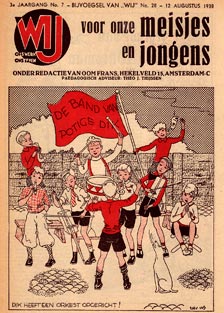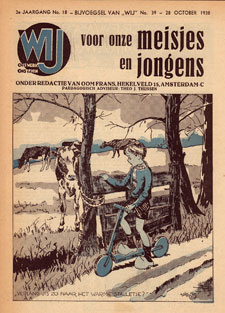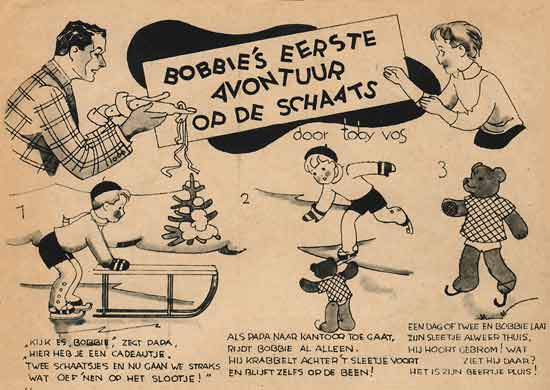Toby Vos was a Dutch illustrator, writer and comic artist, as well as a designer of postcards, building plates and game boards. Her comics and illustrations have appeared in the children's magazine Kleine Wij, the PTT staff magazine Bedrijfsbanden and in the 'Kabouterboekjes' collection of department store De Bijenkorf, but also in schoolbooks, fairy tale collections and children's activity books. Also notable are the illustrated diaries she kept during World War II, which give an intimate and historically interesting look at Amsterdam's resistance movement and the Dutch famine winter of 1944-1945.
Early life
Neeltje Vos (her real name) was born in 1918 in Amsterdam. She utterly disliked her first name. Since her parents had given her the nickname "Toppie", after Dutch writer Top Naeff (of 'School-Idyllen' fame), she later decided to go by the name Toby Vos. Her father died when she was only four years old, leaving Toby to be raised by only her mother in Amsterdam's Jordaan district. Drawing since she could hold a pencil, young Toby dreamed of a career in arts, like her major examples Nora Schnitzler and Freddie Langeler. As a child, she also enjoyed playing theater with her friends, making up her own, overly dramatic stories. A rebellious teen, her only good grade at school was for drawing. However, her mother wanted her to get a job with the same bank as her father used to work, located at the Rokin.
Cover illustrations for Kleine Wij, respectively issue #7 (12 August 1938) and #34 (28 October 1938).
Kleine Wij
Bored out by her daytime bank job, Vos quickly went her own way and presented her drawings to magazines and newspapers. Without any formal education, she was hired by the editors of Wij, the weekly magazine of the socialist publishing house De Arbeiderspers. She became involved with its children's supplement "Wij Voor Onze Meisjes en Jongens", which first appeared on 3 July 1936. It was later renamed to Kleine Wij, and managed to last throughout the early war years, until May 1942. Edited by A.D. Hildebrand under pedagogic supervision of the legendary writer/teacher Theo Thijssen, Kleine Wij contained tales on rhyme, (picture) stories, contests and handicraft sections, with art by Rein Stuurman, Henk Rotgans, Huib de Ru, Piet Worm, Wim Bijmoer, Ger Sligte, William Timym, Joop de Groote, Co Egelie, Henk Kabos, Greetje Kroone and the mysterious Priel. Toby Vos contributed illustrations, as well as a comic strip about a boy called 'Bobbie'.
'Bobbie'.
Luii & Co printing company
During her time at Kleine Wij, Vos got a job as a volunteer at Steendrukkerij Luii & Co, a lithographic printing office at the Lauriersgracht. There, she learned the printing trade and how to produce lithographs, while making drawings for children's and craftwork books, calendars and building plates for children. One project she particularly enjoyed was the dressing doll booklet 'Flipje Op De Boerderij' (1938). In the evenings, she took courses in Applied Arts at the Kunstnijverheidsschool (nowadays known as the Rietveld Academy).
Kabouterboekjes
In 1943, Vos provided the illustrations for two booklets in the collection 'Kabouterboekjes' ("pixie booklets") of the Amsterdam department store De Bijenkorf. The booklets of 12 x 8 centimeters were mostly reworkings of popular fairy tales and stories in comics/picture story format, written and adapted by Sjoert Schwitters. Vos illustrated 'Er Was Eens...' and 'Duimelijntje', while the illustrations for the other eleven installments were made by Lex Metz, Hans Brouwer, Jaap Beckmann and Henk Kabos. Shortly afterwards, Vos also illustrated the children's booklet 'Jaapje en Trui, Het Konijn' (C A. Spin & Zoon, 1944), and volumes in the toddlers' picture book series 'Kleingoed' by J. Riemens-Reurslag.
World War II
During the Nazi occupation of 1940-1945, the self-willed Toby Vos got involved in the resistance movement. She was a courier of illegal radios and the underground newspaper Het Parool, while using her drawing skills to falsify identity documents. During a razzia in 1943, Vos was arrested and questioned by the head of the Sicherheitsdienst (SD), Willi Lages, himself. Fortunately, the group had managed to hide the evidence before their arrest, and Toby was quickly released. From 1944 on, Vos also kept illustrated diaries, in which she documented her wartime experiences in ink and watercolor drawings, reminiscent of the work of Jo Spier. Her diaries also contained comic stories, which not only present accounts of actual events, but also fantasies of even more heroic acts. All in all, the books offer an intimate and confronting look at the life of a resistance worker during World War II.
In September 1944, large parts of Western Europe were liberated by the Allied Forces. However, only the southern half of The Netherlands was now free. Nazi forces fought back intensely, keeping the northern half of the country under occupation for another gruelling nine months. Severe famine broke out, worsened by the very cold winter period. Many people perished from hunger, cold, bombings and the continuing Nazi terror. Vos also documented the misery of this 1944-1945 "Hunger Winter" in her illustrated diaries. When The Netherlands were liberated on 5 May 1945, Vos had survived. The historical importance of her diaries was recognized as early as 1946, when the Dutch State Institute of War Documentation added photocopies to its archives. Because of her wartime heroism, Toby Vos received a pension from the Stichting 1940-1945, starting in 1970.
Illustrations by Toby Vos about the Dutch 'Hongerwinter' ('Winter Famine', 1944-1945).
Freelance magazine work
When the Netherlands were finally completed liberated in the spring of 1945, Toby Vos went to work as a freelance illustrator and writer. She first spent some time in Brussels, Belgium, where she worked for the women's magazine Penelope (approx. 1945-1947). Back in Amsterdam, she began submitting her often personal stories for adults to magazines like Avenue, Hollands Maandblad, Elseviers Weekblad and the literary periodical Maatstaf during the 1950s and 1960s. She was also involved in several staff magazines, most notably Bedrijfsbanden of the telecom company PTT. Between 1947 and 1967, she filled the monthly's children's section 'Voor Jou', using her alter ego "Tante Neeltje". She made stories, puzzles, headers and drawings. Recurring elements were little children, mice and shadow figures. Several stories presented an ironic sense of humor, like the tale about New Year's Eve's final oil dumpling, who is lured by a family of mice into their hole with the prospect of becoming their king. The poor dumpling is however torn to pieces and eaten as soon as he got there.
Book illustrations
Vos also made illustrations for educational books, like a series of Indonesian school books in the Malaysian language, and Leonard de Vries' 'Ontdekkingsreis in Electronenland' (1951). She wrote and illustrated children's activity and puzzle books such as 'Wat Zal Ik Nu Eens Doen?' (Cantecleer, 1953) and 'Weet Jij Het?' (Cantecleer, 1954). Vos' work also included drawings for the fairy tale collection 'De Oude Sprookjes' (1948) and 'Lui Jetje in Luilekkerland' (1948), both by J. Riemens-Reurslag, and also promotional books for De Bijenkorf and Philips. For the Alkmaar based publisher Terra Nova, she made the fairytale text comics 'Klein Duimpje en de Reus' (1951), 'Het Ganzenhoedstertje Aan De Bron' (1951) and 'De Vogel Grijp' (1951). Her commercial work allowed her to experiment with new ideas and techniques.
'Het Ganzenhoedstertje Aan De Bron' and 'De Vogel Grijp'.
Personal life
In the documentary about her life and work, 'Toby Vos - Leven en Werk' (2002), Vos said that drawing was always an essential part of both her professional and personal life. After World War II, she continued to capture scenes of her everyday life in journals. A keen observer with a sharp visual memory, Vos said she always felt inspired. Her urge to draw could only be temporarily paused because of the care for her children or the occasional romantic interludes (like with writer and columnist Hugo Brandt Corstius). With her only marriage ending in divorce in 1952, Vos raised her children as a single mother. When a rental conflict forced her to leave her home in the Van Eeghenstraat in the early 1980s, she ended up in a flat in the Amsterdam Bijlmer, a quickly deteriorating neighborhood. In old age, she however kept her sharp sense of observation, as was illustrated in the aforementioned documentary. She, for instance, wryly commented on the discoloration throughout the years of a tossed away carpet, which hung in a tree in front of her apartment. When she was robbed in the flat's elevator and defended herself with her grocery bag, she couldn't help to notice the contrast between her attacker's appearance and the white yogurt which covered his black face during the struggle.
Death and legacy
Toby Vos lived to become 100 years old, and passed away in Amsterdam in April 2019. In the final years of her life, she couldn't draw anymore because of failing health. Vos has been named a "combination" of Dutch children's author Annie M.G. Schmidt and Schmidt's home illustrator Fiep Westendorp, because she was a writer as well as an illustrator. She however never gained the same fame, which the artist herself attributed to never signing her drawings.
Documentaries about Toby Vos
Between 1998 and 2002, David de Jongh filmed a documentary about her life and work, called 'Toby Vos, Leven en Werk'. The original two-hour version was first broadcast on the Amsterdam open channel Salto in May 2002, and then a trimmed down version appeared on RTV Noordholland in October 2004. This latter version was broadcast on Dutch national television on 10 January 2020. Vos also appeared in De Jongh's documentary 'Foto-Eddy: De Negatieven Van Mijn Vader' (2013), about his father, the eccentric photographer Eddy de Jongh (1920-2002).












